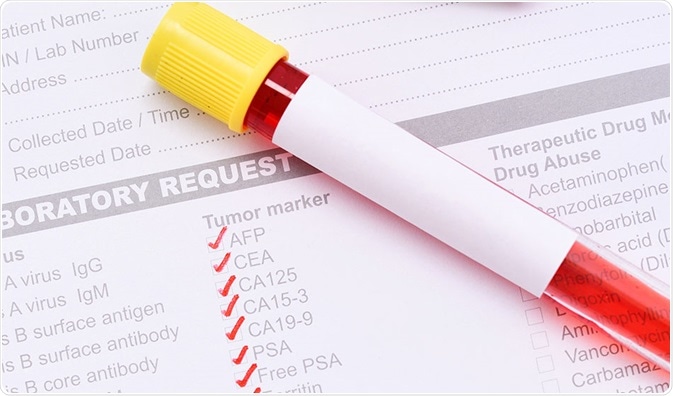Recently, metabolic profiling has attracted interest for the discovery of biomarkers present in the biological system, which can be used to accurately evaluate the underlying mechanism of a disease.

Credit: Jarun Ontakrai/Shutterstock
The field of metabolomics was widely approached through metabolic profiling through a method called targeted metabolomics.
In general, targeted metabolomics is utilized for the purpose of identification as well as quantification of a known set of metabolites, which enables the comprehension of biochemical pathways.
Biomarker study group in metabolic profiling
Metabolomics research on human diseases is widely organized into three categories:
- The first major group of researchers analyzes the pathogenesis of a particular disease.
- The second group focusses on labeling metabolic biomarkers which categorize disease with greater accuracy, in order to improve the disease diagnostics. Targeted metabolomics may furnish biomarkers for the following purposes:
- Identification of diseases at the early stages.
- Prognosis of disease.
- Predicting the response to a particular treatment.
- The third group of researchers focuses on the application of translational opportunities in metabolomics.
Biomarker validation
Biomarkers are otherwise known as molecular biological markers or indicators, which are the natural outputs that allow diseases to be traced with greater sensitivity and precision. Biomarker investigation in metabolomics progresses as a continuum; it starts with the discovery and finishes with the validation method for the ultimate implementation of the biomarker bidder in the metabolomic setting.
In general, targeted metabolic profiling includes three separate study phases in validating biomarkers, which are as follows:
- Discovery phase
- Pre-validation phase
- Validation phase
All the three phases of validation employ the platforms of either nuclear magnetic resonance (NMR) or mass spectroscopy (MS) or a combination of both for effective results.
1. Discovery phase
The discovery phase includes collection of a smaller set of samples, which is commonly named as a “training set.” The information obtained from the training set of samples generates a panel of signature biomarkers.
The fundamental demand is that the discovery phase experiments be strict enough, so that the resulting signature biomarker metabolites are potent and pre-validated. The panel of signature biomarkers obtained from this phase is then subjected to pre-validation studies in order to improve the signature biomarkers to the position of a putative biomarker.
Currently, many researches are working on the discovery of additional biomarkers to establish treatments for achieving complete cure for diseases like cancer, diabetes, and cardiovascular and neurological diseases.
2. Pre-validation method
The pre-validation method is a part of the discovery phase. It employs cross validation to achieve gross precision on biomarker candidates.
Cross-validation method:
It is a statistical method that helps to eliminate some spurious positive biomarkers before the validation stage. It has three types; among these, the “holdout” method is majorly used in biomarker validation.
The holdout method optimizes two sets:
- Training set of samples similar to the discovery phase.
- Testing set, which includes a set of sample population of about 100 people.
The data obtained from the testing set are compared with the preselected putative biomarkers of the discovery stage to eliminate false-positive biomarkers from the panel.
The greater comprehensiveness of both the discovery and pre-validation phases can be achieved using untargeted metabolic profiling. This study increases the confusing aspects that originate from the analytical stages, technical defects of NMR and MA tools, and several other extant biases.
Therefore, a complete validation of labeled as well as pre-validated biomarkers is very important and it must be performed on a larger cohort of samples from different patient sets. Subsequently, the putative biomarker is promoted to the candidate biomarker through cohort studies when it is precisely quantified through cross-validation analysis.
3. Validation phase:
This is the final stage of the validation process, where data of proof for the use of candidate biomarker in clinical practice is generated. The validation method involves conducting large corroboratory studies. It directly tests each candidate biomarker with the collected new independent set of samples from the target population that will comprise a minimum of three groups.
- The first is the control group with healthy volunteers.
- The second group comprises people with a particular disease, for example, type-2 diabetes.
- The third group includes type-2 diabetes patients with an additional disease, such as a coronary heart disease.
Thus, these confirmatory studies on diverse samples determine the capability to make high-quality biomarkers.
Since this study includes significantly larger set of samples, the applied analytical techniques must have high throughput capacity. A large throughput capacity can be achieved with the validation process by using targeted metabolic profiling as the platform.
Limitations of validating biomarker in targeted metabolomics:
- Unfortunately, cohort studies have not continually yielded a great deal of success. In the past 15 years, 150,000 studies have been conducted on biomarker, but only 100 biomarkers have been validated and implemented for clinical use. Thus, a well-designed cohort study is essential for validating the biomarker work.
- Alternatively, using a much controlled population in the validation phase resulted in a very few successful biomarker candidates.
- Also, validating a biomarker candidate, especially in the setting of targeted metabolomics, was found to be quite pricey.
Further Reading
Last Updated: Feb 26, 2019